Magnetocaloric Materials
The magnetocaloric materials research activity began in 2018 with funding from the Hellenic Foundation for Research and Innovation (HFRI). The application goal is magnetocaloric-based refrigeration as an alternative, more energy efficient, cooling technology with a smaller environmental footprint, operating without volatile refrigerants, compared to traditional vapour-compression technologies. Metamagnetic off-stoichiometric Heusler alloys (X2Y1+xZ1-x, where X=Ni, Y=Mn and Z=Sn, In, Ga, Sb) are magnetocaloric materials as they undergo a 1st order magneto-structural transition. A significant advantage of Heusler alloys is that their magnetic properties can be easily manipulated through appropriate alloying. Heusler alloys offer numerous different alloying combinations, since the basic constituent elements can be easily substituted with several others.
In our work special attention is given to Sn-based metamagnetic Heusler alloys, since Sn is a cheap and abundant element, which makes it attractive for commercial applications. For example, epitaxial Sn-based Heusler alloys in the form of oriented sputtered films deposited on single crystal MgO substrates have been investigated: Ni–Mn–Sn (00 1) [011] || MgO (001) [001], at different deposition temperatures (573 K, 673 K and 773 K). Field heating and cooling magnetization curves M(T) of the samples deposited at 573 K and 673 K resemble the behavior of a common ferromagnetic material without any indication of a magnetostructural transition since the magnetization increases continuously with decreasing T. But in the sample deposited at 773 K the desired magneto-structural transition was observed. As can be seen in Fig. 1 below, there is an abrupt change of magnetization around 253 K followed by a Curie transition at higher temperatures. Co substitution for Ni shifts the transformation temperature closer to room temperature, making the material suitable for applications.
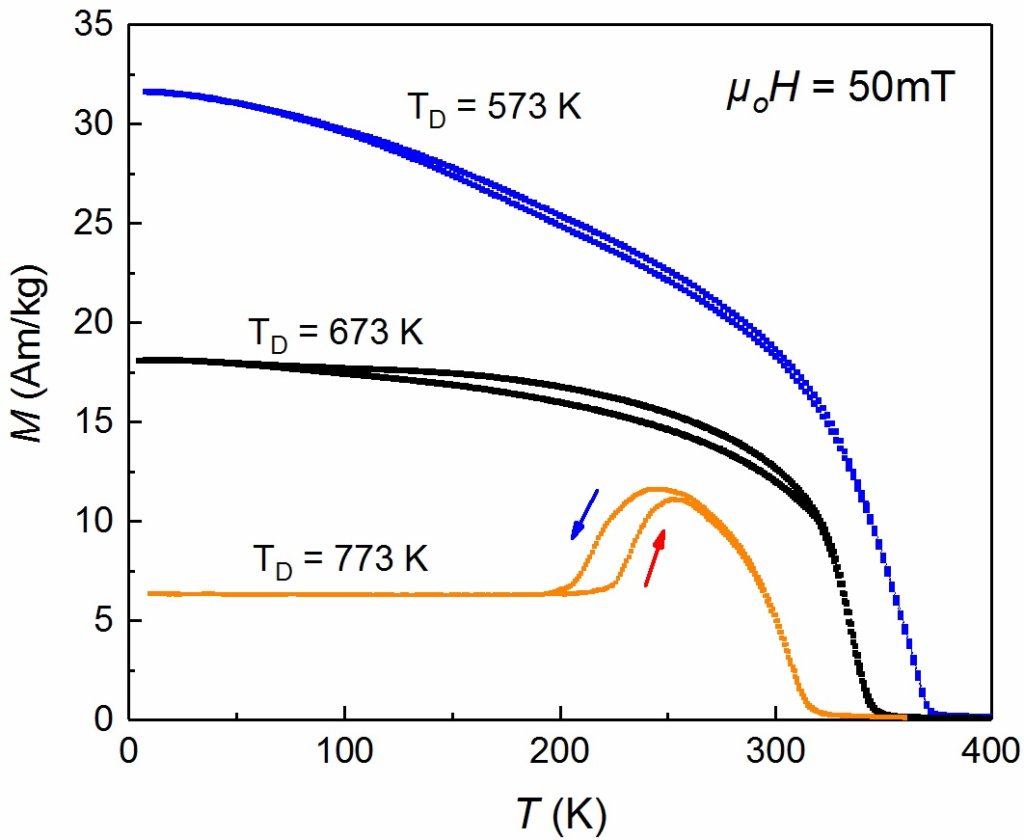
Magnetostructural transitions of metamagnetic Heusler alloys are very sensitive and take place only in a very short range of composition. Particularly in the Ni-Mn-Sn ternary system, magnetostructural transitions occur only in the Mn content range from 35 at.% to 37 at.% Therefore, small composition changes can significantly affect the magnetocaloric properties. In addition, the substitution of Ni with Co shifts the transformation temperature close to room temperature (RT), making the Co-doped alloys suitable for RT cooling applications.
In our investigations of these materials, the use of a combinatorial approach is ideal to explore multi-elements alloys (e.g. quinternary), since allows a fast production, in a single process, and characterization of arrays containing a large number of different compositions, the so-called “materials library”, instead of the conventional approach (one sample in a single process). Co, Fe and Cu were selected as doping elements and the corresponding materials libraries were fabricated based on Ni-Mn-Ga, as the parent compound. The first results showed that Co addition in Ni-Mn-Ga compound results in very low thermal hysteresis (close to 2K) of heating and cooling curves around the transformation temperature (figure below). Thermal hysteresis determines the performance of a magnetocaloric cooling device, since it governs the energy losses in a magnetocaloric thermodynamic cycle. Finally, a 3-doping-elements Ni-Mn-Ga materials library, based on the abovementioned doping elements (Fe, Co, Cu), were fabricated and studied. The complex dependence of the transformation temperature (TMF) and tetragonal ratio of the lattice on the doping composition and their irregular variation are ascribed to the competitive influence of the alloying elements Fe, Co and Cu.
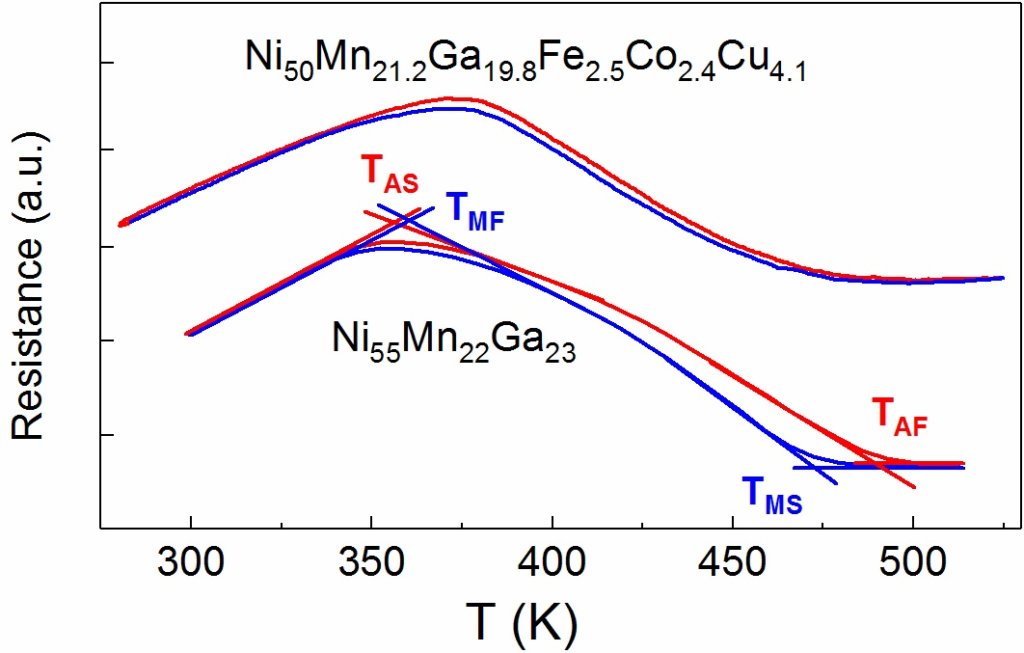
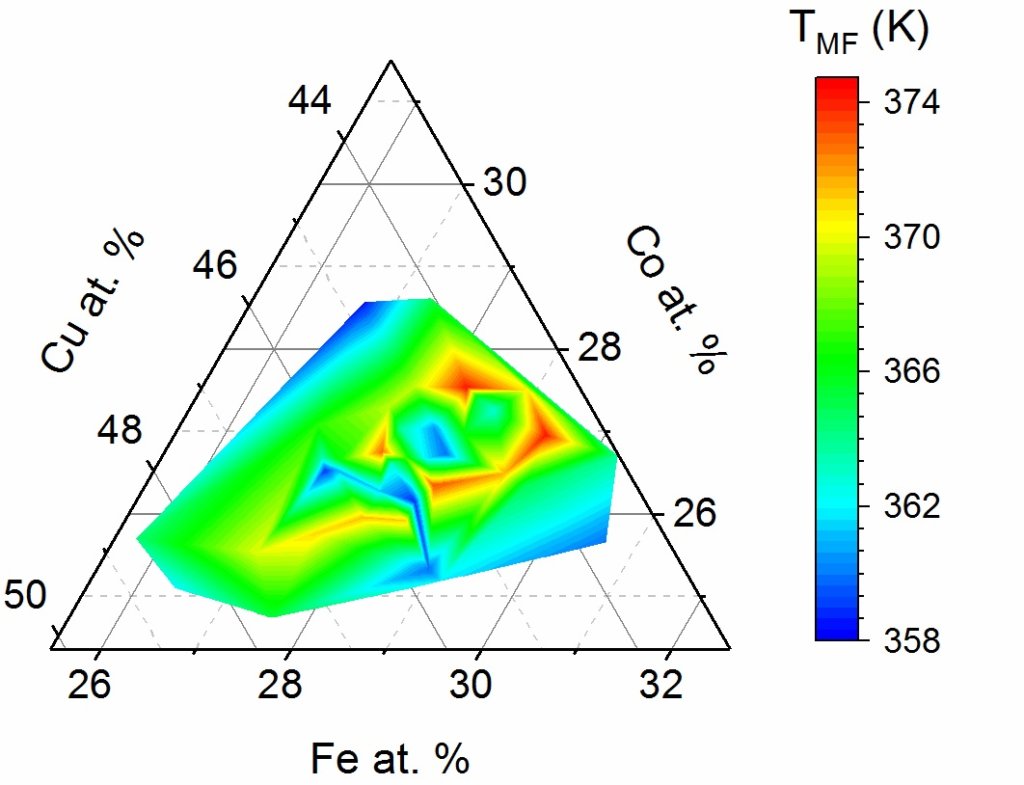
Publication
“Combinatorial synthesis of Ni–Mn–Ga-(Fe,Co,Cu) high temperature ferromagnetic shape memory alloys thin films” V. Alexandrakis et al, Scripta Materialia volume 178, pages 104–107, (2020)
Generally, structural and magnetic properties of NiMn-based metamagnetic Heusler alloys in form of thin films can dramatically differ from those in the bulk, particularly, due to the interaction between the film and the substrate. Martensitic transformation (from the cubic austenite phase to the lower symmetry martensitic structure) in thin films cannot occur without twinning, because the surface area of the film on rigid substrate should remain the same during the transformation.
It was found that constraints from the film/substrate interface block the martensitic transformation in the 20 nm thick film. The increase of the film thickness results in a progressive stress relaxation and, as a result, the martensitic transformation becomes possible starting from 50 nm. Twinning of the films is required to conserve the films surface area. The elastic energy balance between the film/substrate interface and the twin boundaries leads to the formation of a submicron wide, stripe like, periodical structure of twins. The width of the twin variants increases with the film thickness growth, resulting in a significant modification of magnetic properties.
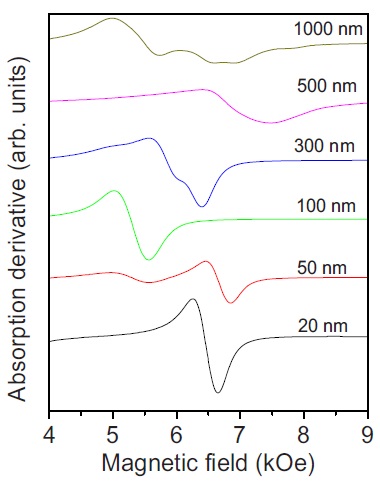
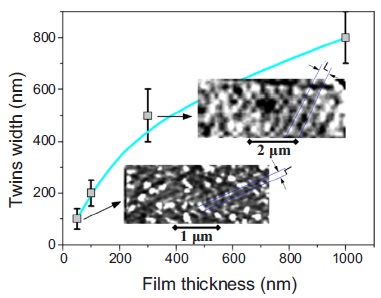
Publications
“Thickness dependences of structural and magnetic properties of Ni(Co) MnSn/MgO(001) thin films, Journal of Alloys and Compounds, 862, 158474 (2021)
“Spontaneous Zero-Field Cooling Exchange Bias in Ni–Co–Mn–Sn Metamagnetic Heusler Sputtered Film”, Nanomaterials, 11, 2188 (2021).